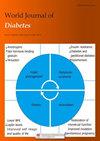Unlocking new potential of clinical diagnosis with artificial intelligence: Finding new patterns of clinical and lab data.
IF 4.2
3区 医学
Q1 ENDOCRINOLOGY & METABOLISM
引用次数: 0
Abstract
Recent advancements in science and technology, coupled with the proliferation of data, have also urged laboratory medicine to integrate with the era of artificial intelligence (AI) and machine learning (ML). In the current practices of evidence-based medicine, the laboratory tests analysing disease patterns through the association rule mining (ARM) have emerged as a modern tool for the risk assessment and the disease stratification, with the potential to reduce cardio-vascular disease (CVD) mortality. CVDs are the well recognised leading global cause of mortality with the higher fatality rates in the Indian population due to associated factors like hypertension, diabetes, and lifestyle choices. AI-driven algorithms have offered deep insights in this field while addressing various challenges such as healthcare systems grappling with the physician shortages. Personalized medicine, well driven by the big data necessitates the integration of ML techniques and high-quality electronic health records to direct the meaningful outcome. These technological advancements enhance the computational analyses for both research and clinical practice. ARM plays a pivotal role by uncovering meaningful relationships within databases, aiding in patient survival prediction and risk factor identification. AI potential in laboratory medicine is vast and it must be cautiously integrated while considering potential ethical, legal, and pri-vacy concerns. Thus, an AI ethics framework is essential to guide its responsible use. Aligning AI algorithms with existing lab practices, promoting education among healthcare professionals, and fostering careful integration into clinical settings are imperative for harnessing the benefits of this transformative technology.利用人工智能挖掘临床诊断的新潜力:寻找临床和实验室数据的新模式
近来科学技术的进步,加上数据的激增,也促使实验室医学与人工智能(AI)和机器学习(ML)时代相融合。在当前的循证医学实践中,通过关联规则挖掘(ARM)分析疾病模式的实验室检验已成为风险评估和疾病分层的现代工具,具有降低心血管疾病(CVD)死亡率的潜力。心血管疾病是公认的全球主要死亡原因,由于高血压、糖尿病和生活方式选择等相关因素,印度人口的死亡率较高。人工智能驱动的算法为这一领域提供了深刻的见解,同时应对了各种挑战,如医疗保健系统面临的医生短缺问题。在大数据的推动下,个性化医疗需要将 ML 技术与高质量的电子健康记录相结合,以指导取得有意义的成果。这些技术进步增强了研究和临床实践的计算分析能力。ARM 通过发现数据库中的有意义关系、帮助预测患者生存期和识别风险因素,发挥着举足轻重的作用。实验室医学中的人工智能潜力巨大,必须谨慎整合,同时考虑潜在的伦理、法律和隐私问题。因此,人工智能伦理框架对于指导其负责任的使用至关重要。将人工智能算法与现有的实验室实践相结合,促进对医疗保健专业人员的教育,并促进与临床环境的谨慎整合,是利用这一变革性技术带来的好处的当务之急。
本文章由计算机程序翻译,如有差异,请以英文原文为准。
求助全文
约1分钟内获得全文
求助全文
来源期刊

World Journal of Diabetes
ENDOCRINOLOGY & METABOLISM-
自引率
2.40%
发文量
909
期刊介绍:
The WJD is a high-quality, peer reviewed, open-access journal. The primary task of WJD is to rapidly publish high-quality original articles, reviews, editorials, and case reports in the field of diabetes. In order to promote productive academic communication, the peer review process for the WJD is transparent; to this end, all published manuscripts are accompanied by the anonymized reviewers’ comments as well as the authors’ responses. The primary aims of the WJD are to improve diagnostic, therapeutic and preventive modalities and the skills of clinicians and to guide clinical practice in diabetes. Scope: Diabetes Complications, Experimental Diabetes Mellitus, Type 1 Diabetes Mellitus, Type 2 Diabetes Mellitus, Diabetes, Gestational, Diabetic Angiopathies, Diabetic Cardiomyopathies, Diabetic Coma, Diabetic Ketoacidosis, Diabetic Nephropathies, Diabetic Neuropathies, Donohue Syndrome, Fetal Macrosomia, and Prediabetic State.
 求助内容:
求助内容: 应助结果提醒方式:
应助结果提醒方式:


